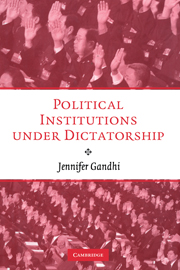Book contents
- Frontmatter
- Contents
- List of Tables and Figures
- Acknowledgments
- Introduction
- 1 The World of Dictatorial Institutions
- 2 Three Illustrative Cases
- 3 Use of Institutions to Co-opt
- 4 Institutions and Policies under Dictatorship
- 5 Institutions and Outcomes under Dictatorship
- 6 Institutions and the Survival of Dictators
- 7 Conclusion
- 8 Codebook of Variables
- Bibliography
- Author Index
- Subject Index
1 - The World of Dictatorial Institutions
Published online by Cambridge University Press: 25 July 2009
- Frontmatter
- Contents
- List of Tables and Figures
- Acknowledgments
- Introduction
- 1 The World of Dictatorial Institutions
- 2 Three Illustrative Cases
- 3 Use of Institutions to Co-opt
- 4 Institutions and Policies under Dictatorship
- 5 Institutions and Outcomes under Dictatorship
- 6 Institutions and the Survival of Dictators
- 7 Conclusion
- 8 Codebook of Variables
- Bibliography
- Author Index
- Subject Index
Summary
INTRODUCTION
The contrast between democracy and dictatorship — in structures, policies, and performance — has been the object of intense scrutiny. Yet little consensus exists over the definition of regime type. What cases qualify as “democracies”? Which cases constitute the universe of “dictatorships”? The latter question is easy to answer when we encounter the ferocity of a Joseph Stalin or a Pol Pot. No one would quarrel with labeling their regimes as dictatorships. But other regimes are more controversial. For almost seven decades, a new president in Mexico was elected every six years. Nevertheless, the same party's candidate always won. Or consider Singapore, where Lee Kuan Yew crushed political competition for over thirty years. Yet continuous measures of regime type rate him somewhere in between “most autocratic” and “most democratic.”
Part of the problem is that dictatorial rulers are quite inventive in how they organize their rule. Decision-making power is concentrated in everything from juntas to politburos to family councils, for example. Yet the institutional inventiveness of dictators is most apparent when they govern with nominally democratic institutions, such as legislatures and political parties. Dictators frequently govern with legislatures, some of which have formal law-making powers, whereas others serve only to “advise and counsel.” Membership to assemblies may be by appointment or by election. In elections, candidates may use party labels or may be forced to run as independents.
- Type
- Chapter
- Information
- Political Institutions under Dictatorship , pp. 1 - 41Publisher: Cambridge University PressPrint publication year: 2008

